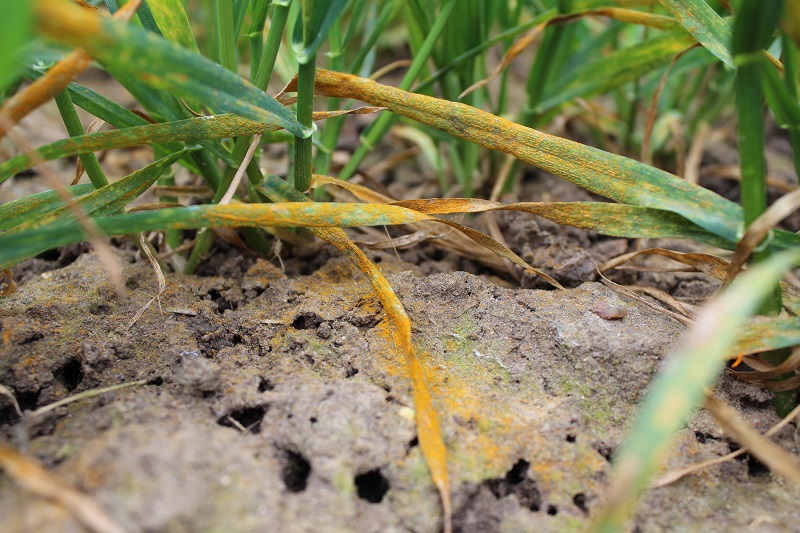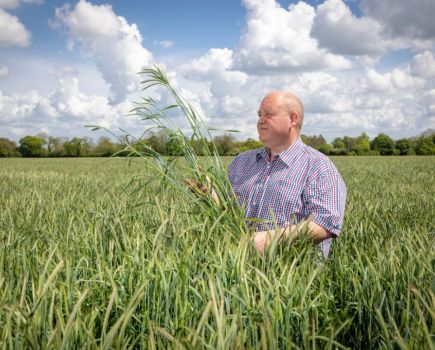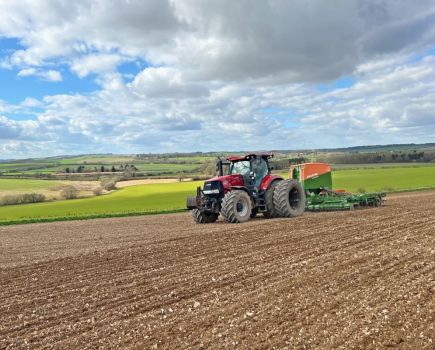Every year in early March a group of plant breeders, researchers and agronomists gather in Cambridge to hear the results of the UK Cereal Pathogen Virulence Survey. CPM was there to find out if there was an explanation for the unexpected incidences of yellow rust reported in some varieties last year.
It’s likely new pathotypes will spread in 2020.
By Lucy de la Pasture
Something strange was happening in KWS Zyatt winter wheat last year. In some areas yellow rust was being detected at an unexpectedly high level for a variety that was rated 8 for resistance on the AHDB Recommended List. Alarm bells rang and the largest number of samples received for testing by UK Cereal Pathogen Virulence Survey (UKCPVS) were from fields of Zyatt, according to NIAB plant pathologist Amelia Hubbard.
Confirmation that a new strain of yellow rust was responsible for the sporadic breakdown in Zyatt’s resistance won’t be possible until the results of genotyping come in later this year, but the differential tests that are part of the UKCPVS protocol have identified ten new pathotypes, which were predominantly isolated from Zyatt samples.
“A pathotype lists the virulence genes the isolate carries and virulence on any additional test cultivars infected at the seedling stage during UKCPVS tests,” explains Amelia. “More of the new isolates had a susceptible reaction on Yr8, Kranich and Crusoe than we’ve detected in previous years. Some isolates also appear to be avirulent on Yr1 and Yr9 but with virulence for Yr8.”

Amelia Hubbard says some of new pathotypes detected last year have very similar virulence to the Hereford race of yellow rust.
The appearance of pathotypes with this new combination of virulent and avirulent characteristics indicates a further evolution of the yellow rust pathogen in the field, but are there any parallels that can be drawn with other known European races?
Amelia says the new UK pathotypes with avirulence for Yr1 and Yr9 in combination with virulence for Yr8 are similar, but not identical to the Hereford race – designated PstS12 by the Global Rust Reference Center. The Hereford race is one UK pathologists are keeping a keen eye on because the Hereford variety is found in the breeding lineage of a number of varieties on the RL.
“The Hereford race has the pathotype 2,3,6,7,8,17,25,32,AvS and has been seen at a low frequency in Sweden during 2015-17,” she explains. “The two new isolates we detected in 2019 have pathotypes 2,3,4,6,7,8,17,25,32,Sp,Ro,So,Ca,St and 2,3,4,6,7,8,17,25,32,Ro,So,Ca.”
Since yellow rust pathogens from the original Warrior group (Pink) of isolates first arrived in 2011, the potential for new pathotypes to emerge increased dramatically and the insurgent population quickly replaced the previously dominant clonal lineages in the UK.
The diversity in the yellow rust population has been increasing since, with Blue and Red groups probably present from the 2011 incursion. The range of pathotypes became even greater in 2015, when the Purple (Kranich) group was found UK, explains Dr Diane Saunders, researcher at John Innes Centre (JIC).
A dramatic shift in the pathogen population in 2016 caused a major revision of RL yellow rust ratings and marked the dominance of pathotypes from the Red group – with Red 24 in particular responsible for the breakdown in varietal resistance. Since 2017 the Red group has dominated the UK population, representing 93% of the UKCPVS samples genotyped, and within the group there is a broad range of virulence profiles. In 2018 no isolates from the Pink or Blue groups were seen and, within the Red group, Red 27 was most frequently detected, followed by Red 23.
One of the problems in interpreting data from UKCVPS is its historic nature – the genotyping is a time-consuming process which means the complete picture for yellow rust in 2019 isn’t publicly available until the UKCVPS final report is released in Oct 2020.
Recognising the changes in pathotypes detected and unusual performance of a few varieties in some locations in the field during 2019, the AHDB reduced the resistance rating of Zyatt, Bennington and Viscount by one point in the current 2020/21 RL.
“RL ratings are calculated using data from three years, across the country but new races can emerge sporadically and may not be uniformly distributed – as seemed to happen last year with Zyatt. In 2016, the changes in varietal performance were seen across the country and ratings were reassessed in response to this based on one year of data only,” explains Amelia.
“In 2019, because the changes in varietal performance were sporadic, the RL ratings are based on three years of data. But it’s likely new pathotypes will spread in 2020 and this will be captured in the RL 2021/22 ratings.”
There’s a footnote in the current RL which says, “It’s not yet clear if reported cases of high rust indicate initial emergence of new rust races or high disease pressure. The highly dynamic nature of the rusts means all varieties should be closely monitored and local rust populations may differ from general UK population.”
NIAB technical director Bill Clark believes this new rating doesn’t adequately reflect the levels of yellow rust some growers were faced with last year and that a better system would be for the RL to reflect the worst-case scenario rather than expressing the three-year average.
“For some growers in Essex a yellow rust rating of 7 for Zyatt is completely out of kilter after the levels of disease they experienced in their crops,” he says.
Former UKCVPS leader, Dr Rosemary Bayles is in agreement with Bill. “Regardless of the science around races, it underlines the critical importance of keeping a close eye on what yellow rust is doing in the field each season and basing variety ratings on this, rather than multi-year averages,” she stresses. “It’s equally important we heed the warnings we get from single locations, rather than losing sight of these outliers in averages.”
While she has seen clear changes in yellow rust populations in 2019, they come as absolutely no surprise to Rosemary, who co-ordinates Agrii’s national cereal disease survey, established with leading wheat breeder, Bill Angus. Nor does she consider any new race or sudden ‘breakdown’ to be involved.
For the past five seasons, she has overseen the network of 12 disease monitoring sites from Carnoustie in Scotland to Taunton in Somerset. Here, around 30 varieties – carrying known rust resistance genes and representative of the span of commercial wheat genetics – are grown untreated and exposed to natural infection in small ‘tussock’ plots alongside the company’s national and regional variety trials programme.
Regular monitoring of yellow and brown rust development in these plots allows Rosemary to provide Agrii agronomists and customers with the most up-to-date intelligence on variety susceptibility for the most effective risk management.
“What we’ve seen in our survey this season is simply confirmation of what we’ve been warning about for the past two years. Yellow rust populations are continuing to show high levels of virulence for varieties like Solstice, Robigus, Claire and JB Diego. In addition, we are seeing increases in virulence for a number of other varieties that are by no means new but have been uncommon in recent years.
“The most significant change we’ve seen this season is much greater virulence for the parent variety, Hereford. This virulence has been detected in the past, but the first indication we had of a possible upsurge was at a single site in 2017, where infection reached 25% on the variety.
“Having detected infections more widely in 2018, we warned that varieties with Hereford in their pedigree should be monitored especially closely in 2019. The evidence of the past season shows this warning was very timely.”
Based on scoring in untreated plots in the company’s parallel national and regional variety trials, Agrii Wheat Advisory List yellow rust resistance ratings for Zyatt, Gleam, Shabras and Dunston – all of which have Hereford in their close pedigree – have been reduced markedly from their 2018 levels. In the case of Zyatt and Dunston – both still rated as over 7.0 on the RL – to just 3.7 and 2.7 respectively.
Bill suggests growers pay little heed to adult plant resistance and if yellow rust is active in the field then it should be treated. “The mechanism behind adult plant resistance isn’t fully understood and will ‘kick in’ at different times in different varieties, sometimes as late as GS39. That means it can’t be relied upon to help combat infection before green leaf is lost and the yellow rust pathogen is so dynamic, the varietal resistance may not be as expected anyway.”
The UKCPVS is working with the John Innes Centre to introduce a rapid genotyping test that’s already been deployed to help wheat growers in Ethiopia. It will mean any significant changes in the yellow rust population can be highlighted in season using MARPLE diagnostics, which looks at just 242 selected genes in the yellow rust pathogen rather than the 14,000 active genes currently sequenced and analysed in the lab, explains Diane.
“Only a few genes are needed to define individual strains of yellow rust and we’ll also be able to detect any changes in the gene coding CYP51. This means if there’s a shift in azole sensitivity, it will be picked up in season using the mobile sequencing device,” she says.
Breeder’s view on KWS Zyatt
Yellow rust on KWS Zyatt is nothing new, says KWS winter wheat breeder Mark Dodds. “It’s never been on the shortlist of those showing seedling rust resistance tested, so there was always an early season risk with the variety. We’ve always seen a little yellow rust on it later in the season.
“Yellow rust levels increased in a number of varieties last year and there was a large amount of variability between sites. On the sites where Zyatt had more yellow rust than expected, levels tended to be similar to Skyfall, so easily controllable with a sensible fungicide program.”
But yellow rust remains a very emotive subject, says KWS product development manager John Miles.
“A lot of varieties need watching for seedling infection, but yellow rust is relatively easy to control with a good range of available chemistry as long as gaps are not stretched too far. Zyatt has really good Septoria resistance levels (6.4) which, in reality, is a much bigger challenge post CTL than yellow rust.
“With just one new variety with breadmaking potential in HGCA Recommended List testing for harvest 2020, Zyatt and the other recommended Group 1 varieties will undoubtedly continue to form the bedrock of supply for the milling industry in the next few seasons.”
Sclerotinia protection gets a boost
Following its success in cereals, Aviator XPro (bixafen+ prothioconazole) has gained approval in oilseed rape to tackle sclerotinia and light leaf spot as a flowering spray.
The approval comes at a time when there’s a growing trend towards just one spray at flowering to reduce costs, an approach which elevates the importance of using the most effective option available, believes Bayer’s Jennie Watson.
“Through extensive testing of Aviator in OSR in the years leading up to its approval (17 trials in the UK, Germany and France, 2007 – 2010), we’ve seen it accomplish 5% greater control of sclerotinia than Proline (prothioconazole) from a single application at early-full flowering.
“Analysis has shown Aviator provides more than £35/ha margin over input cost (with OSR at £387/t) even in the absence of disease, making it a compelling option at flowering,” says Jennie.
She explains that the increased chlorophyll level brought about by Aviator in cereals is the same in OSR. “It’s a more rounded option than straight Proline, with two modes of action to support resistance management as well as benefiting from its formulation system.”
Bayer’s patented ‘Leafshield’ formulation system improves the spreading, penetration and drying of Aviator. This feature is particularly notable on the waxy leaves of OSR and was demonstrated in a study conducted by Silsoe Spray Application Unit (SSAU), says Jennie.
“We used time-lapse photography to compare the speed and spreading capabilities of multiple flowering spray products on OSR leaves,” explains Andy Lane, senior research scientist at SSAU.
“During the study, it was clear that where a droplet landed on the leaf surface had a direct impact on how quickly the product spread. As soon as spray droplets reached a leaf vein, then it spread very rapidly along it and then onto the leaf surface,” he says.
Andy and his colleagues conducted the study by pipetting a 2µl droplet of product onto an OSR leaf – not on a vein – and then captured how far and how quickly it spread across the leaf.
“We found that Aviator was very aggressive in its spreading on the leaf. It spread the quickest and covered the greatest surface area of all the products trialled,” he explains.
“We know that Proline has a good formulation, but this study demonstrates the benefits of Leafshield and how it’s helping maximise Aviator’s performance,” adds Jennie.
Independent agronomist and AICC member, David Lines, has noticed the same effect in the field as SSAU have recorded in the lab. When using Aviator at the sclerotinia spray timing he observed the speed it stuck to and coated petals.
“There’s something in the formulation that ensures the product adheres to petals and stems very effectively and quickly. In my view, it’s probably one of the wetting agents. We see similar properties with Aviator and Ascra in wheat, where you can easily see the change in leaf colour after application.”
It’s a potential benefit since petal fall is the driver for the spreading of sclerotinia. A flowering spray to target the disease is normally a given in David’s high rainfall patch in Herefordshire – the real decision is whether to apply one or two sprays.
“Protection is required throughout the flowering period, which can be extended in cooler conditions. There isn’t a curative option, so if the disease gets established there’s little you can do,” he adds.
When it comes to fungicide choice, David would use the most potent products as the first flowering spray. “It has a similar level of importance as a flag leaf spray in wheat – it’s the first phase in establishing a protective position and might be the only one if flowering is short. If the flowering period is extended, you can come in with a top-up if need be. This typically would be three weeks later,” he says.




